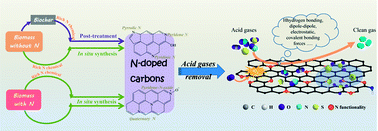The preparation of waste biomass-derived N-doped carbons and their application in acid gas removal: focus on N functional groups
Abstract
N-doped biochars (NPCs) derived from waste biomass are promising materials for the removal of acid gases, while waste biomass is a cheap and sustainable resource. Also, the incorporation of nitrogen (N), especially N-groups in the carbon lattice, has a positive effect on acid gas removal. The doped N improves the basicity of carbon surfaces and forms superoxide radicals, thus enhancing the adsorption and catalytic performance of carbon materials. However, the acid gas removal performance of NPCs is closely related to the resultant N functionalities. Understanding the mechanism of N incorporation is beneficial for the design of NPCs with outstanding performance. In this paper, the preparation of NPCs derived from waste biomass and their application in acid gas removal (i.e., CO2, H2S, SO2, and NOx) are reviewed. The N species on the NPC surfaces, the effects of synthesis strategies on N configuration and N content, and related N-doping mechanisms are summarized and discussed. Moreover, the application in acid gas treatment of waste biomass-based NPCs is presented in detail. Finally, we propose a prospective investigation into the application of waste biomass-derived NPCs in the acid gas removal and catalysis fields.

- This article is part of the themed collection: Journal of Materials Chemistry A Recent Review Articles


 Please wait while we load your content...
Please wait while we load your content...